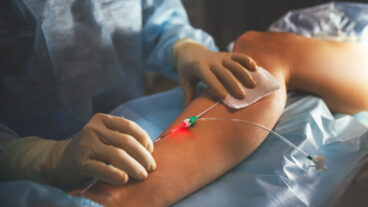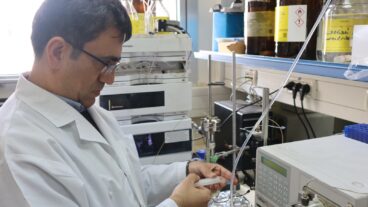The NewSit – “Even the best seat in business classes causes DVT if the people sit there without movement,” says Arnold Jonas.A new Israeli-developed airline seat that allows air travelers to move their legs more freely during a flight could reduce the risk of deep vein thrombosis (DVT) in air travelers according to a new study.
The research by Dr. Harry Abramowitz and Prof. David Gertz, both from the Department of Surgery and the Vascular Surgery Unit of Shaare Zedek Medical Center in Jerusalem, shows that of 25 volunteers who tested the modified seat, NewSit, developed by Israeli entrepreneur Arnold Jonas, 23 saw improvements in their leg volume after using the seat.
The volunteers, aged between 21 to 61, were asked to sit on a normal airline seat continuously for five hours. Air plethysmography (APG) was used to measure the venous volume of their leg calves both before and after the test. A week later the same experiment was carried out on the modified seat.
“The mean percent increase in venous volume for the conventional seat after five hours of continuous sitting was significantly greater than that of the modified seat,” the report, published in the Annals of Vascular Surgery, stated.
“These are extremely promising results,” Jonas told ISRAEL21c, speaking from Orange County in California. “After sitting on the conventional seat, volunteers saw the venous volume of their leg swell by about 26 percent, while after sitting on the modified seat swelling increased by just 3%. This means that the blood circulation was close to normal.”
DVT is the formation of a blood clot in one of the deep veins of the body, usually the legs. It occurs mostly in people who have been immobile for long periods, such as a flight. Blood passing through the deepest veins in the calf or thigh, begins to flow more slowly and a clot can occur. Once this clot reaches the heart or the brain, the damage is caused. In the US, about 200,000 people die of complications due to DVT every year, according to pharmaceutical company Sanofi-Aventis, and about half of these deaths are thought to be related to air flights.
The phenomenon is often called ‘economy class syndrome’ since coach travelers are stuck for hours in uncomfortable and cramped seats. In fact, however, as Dick Cheney, vice-president of the US, discovered in March, business flyers are also at risk. Cheney was given medical treatment after suffering DVT in his left leg during a 25,000-mile tour of the Asia-Pacific, despite the fact he traveled in comfort in an exclusive compartment on Air Force Two. “Even the best seat in business classes causes DVT if the people sit there without movement,” says Jonas.
While everyone is at risk from DVT, there are some passengers with a higher risk than others. These include passengers seated in non-aisle seats, for whom it is much harder to get up and walk around, smokers, drinkers, people with heart disease, pregnant women, people over 40, women on birth control and post-surgical patients. Long haul flights are considerably more dangerous than short flights. The report quotes a study of 135 million passengers carried out over a 10-year period at Charles de Galle Airport in France. The incidence of pulmonary embolism after flights of less than 3,000 miles was 0.11 per million passengers, but increased to 4.77 per million for flights over 6,000 miles.
Today there are thousands of lawsuits against airline companies and air seat manufacturers by people, or their relatives, who have suffered from DVT after a flight.
Jonas invented NewSit after spending a number of years commuting once a month between Israel and California. The seat, which has been patented, looks like a regular seat but is made in two parts. With the push of a button, the front quarter of the seat rises up, lifting the passenger’s legs off the floor, and enabling him to swing them back and forth in the narrow space between the seats. The swinging movement by itself is good to increase blood circulation, but on the swing down, the passenger also compresses his calf muscle against the cushion, which further helps to circulate the blood. At present the movement must be initiated by the passenger himself, but it is possible to automate the chair so that it can move while a passenger is asleep.
Aside from helping blood circulation, the seat also provides a more comfortable sitting and sleeping option for passengers, by providing an additional four inches of leg support.
The Shaare Zedek study began late last year and was completed recently. In conclusion it states: “The results of this study suggest that a modification of this kind, by enhancing venous empting and reducing venous stasis, removes what is considered to be major, if not the principal, risk factor for VTE [pulmonary embolism] during prolonged air travel.”
Jonas is now looking for investment and plans to approach airline companies, and airseat manufacturers.
The cost of NewSit is estimated to be about 10 percent more than conventional seats. A standard economy class seat costs in the region of $2,300 but prices can go up to $10,000 according to the luxury level. Jonas believes this will not deter airlines, and suggests that they could introduce a new class on the airplane with these seats in place. The airlines could charge an additional sum for passengers who would like to use these seats.
“If people are willing to pay a premium of $1,500 to sit in business class, I’m sure they would be willing to pay an additional $50 to sit on a seat that could give them a chance to avoid DVT,” says Jonas.












